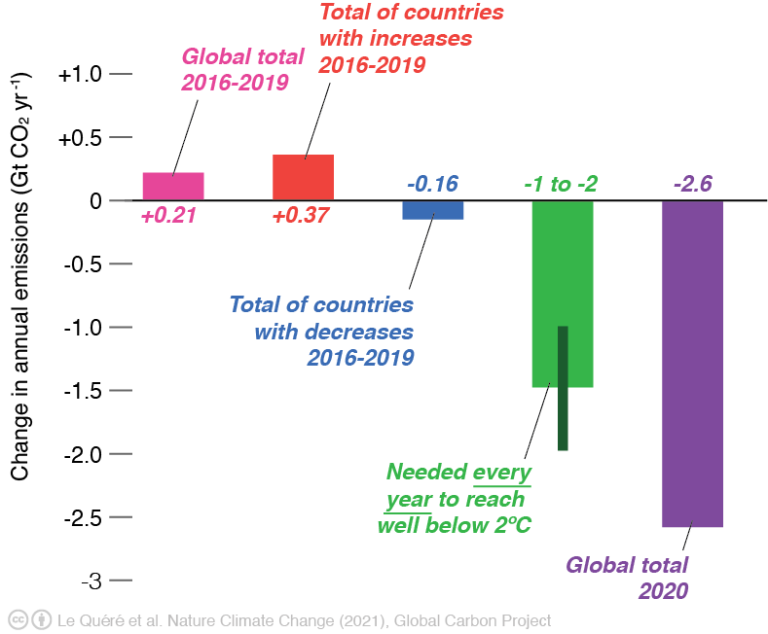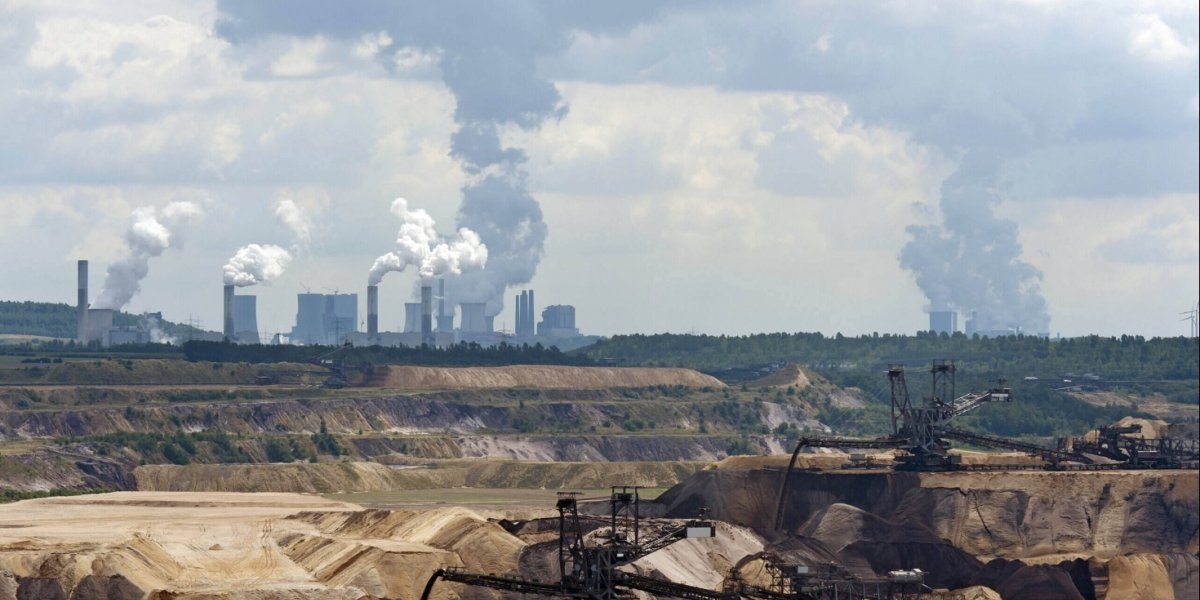POWER PRODUCTION IS A LARGE SOURCE OF co₂ EMISSIONS IN MANY COUNTRIES. IN THIS PICTURE, YOU SEE A LIGNITE MINE IN NORTH-RHINE WESTPHALIA IN GERMANY, WITH LIGNITE-FIRED POWER PLANTS NEURATH AND NIEDERAUSSEM IN THE BACKGROUND. PHOTO CREDIT: GETTY IMAGES.
Climate policies must intensify to accelerate emission reductions in the post-COVID era
Global co₂ emissions declined sharply in 2020, but with a rebound expected in 2021 efforts must be intensified if the world is to reach the targets of the Paris Climate Agreement and keep global warming well below 2°C, a new study shows.
The study, which has been conducted as part of the Global Carbon Project, was published in the scientific journal Nature Climate Change on 3 March 2021. It has been led by Professor Corinne Le Quéré of the University of East Anglia in the United Kingdom. Researchers Glen Peters and Robbie Andrew at CICERO Center for International Climate Research are among the authors of the study.
“The COVID-19 pandemic came as global CO2 emissions were showing signs of a slowdown. The post-COVID era is a unique opportunity to lock in these earlier gains and use recovery funds to accelerate change,” says Glen Peters, a research director at CICERO.
According to the study, 64 of the world’s countries cut their CO2 emissions in the period 2016-2019 compared to 2011-2015, while 150 countries saw their emissions increase. On balance, global CO2 emissions grew by an average of 0.21 billion tonnes per year from the 2011-2015 period to the 2016-2019 period.

Modest CO2 cuts are only occurring in a subset of countries
Many countries have taken action to reduce or slow down the growth in emissions, and there are currently more than 2,000 different climate change laws and policies in place across the world.
Many wealthier countries have managed to cut emissions, while in the middle-income countries, the growth in emissions has started slowing down. In these countries, lower growth or declines in energy use have allowed clean technologies to displace older fossil technologies at a faster rate.
The COVID-19 pandemic came as global CO2 emissions were showing signs of a slowdown. The post-COVID era is a unique opportunity to lock in these earlier gains and use recovery funds to accelerate change.
GLEN PETERS, RESEARCH DIRECTOR AT CICERO CENTER FOR INTERNATIONAL CLIMATE RESEARCH.
Meanwhile, in lower income countries, emissions showed no notable slowdown in 2016-2019 compared with the previous two five-year periods. These countries are greatly expanding their energy use as they develop their economies, with fossil fuels driving much of that expansion.
“Efforts to cut CO2 emissions are starting to pay off in a subset of countries, but actions are neither large-scale nor widespread enough,” says Robbie Andrew, a senior researcher at CICERO.
The size of the rebound in 2021 is a key uncertainty
Throughout the 2020s and beyond, global CO2 emissions must decrease by 1-2 billion tonnes annually if we are to manage to reach the goals of the Paris Agreement and keep the global temperature rise this century well below 2°C above pre-industrial levels, and pursue efforts to limit the increase to 1.5°C.
Since the Industrial Revolution in the late 1700s, the world has already become over 1°C warmer on average due to the greenhouse gas emissions resulting from human activities.
Global CO2 emissions fell by over 2 billion tonnes in 2020 amid the coronavirus pandemic, a record amount and a drop of about 7 percent compared with 2019 levels. The decrease was a result of the restrictions introduced across the world to slow the spread of infection, but as these restrictions have been lifted and recovery packages deployed, emissions have already started to rebound.
Fossil fuel-based infrastructure remains little changed
The measures used to tackle the COVID-19 pandemic have impacted the use of fossil fuels but have had little impact on fossil fuel-based infrastructure. As confinement measures are relaxed, that infrastructure is set into use again, leading to a rebound in CO2 emissions.
Some behavioural changes may persist – such as increases in working from home in richer countries – and could lead to sustained changes in emissions.
"Emissions were lower in 2020 as fossil fuel infrastructure was used less, not because infrastructure was closed down,” says Peters. “When fossil fuel infrastructure is put into use again, there is a risk of a big rebound in emissions in 2021, as was seen in the wake of the Global Financial Crisis in 2009" says Peters.
Poor targeting of economic recovery packages could therefore be a big facilitator of a rebound in CO2 emissions in 2021 and subsequent years, according to the researchers.
“Unless the COVID-19 recovery directs investments into climate-compatible infrastructure, emissions could well surpass those of 2019 within a year or two, and lock future emissions in for decades,” says Andrew.
“The challenge for policymakers will be to stimulate the economy through the lens of future clean technologies and behaviours, such as renewable energy, electric vehicles, public transport, and walking and cycling for shorter trips,” Andrew adds.
Unless the COVID-19 recovery directs investments into climate-compatible infrastructure, emissions could well surpass those of 2019 within a year or two, and lock future emissions in for decades.
ROBBIE ANDREW, SENIOR RESEARCHER AT CICERO CENTER FOR INTERNATIONAL CLIMATE RESEARCH.
